What is a Computerized Particle Analyzer? (Definition, Models, & How To Use + Video)
“Is there something out there that can do what my test sieve shaker does, but better or faster?”
"What is a computerized particle analyzer?"
Whether you’re currently using test sieves and a sieve shaker or looking to explore other particle analysis options, these are just some of the questions you may be asking yourself.
The W.S. Tyler Computerized Particle Analyzer (CPA) is bringing new technology to the world of particle analysis.
This article was written to give you a better understanding of what a computerized particle analyzer is, describe the different models, and help you decide if a computerized particle analyzer is right for you.
What Is a Computerized Particle Analyzer (CPA)?
Over the last 100 years or so, there has been little to no change in the particle analysis industry.
It has been a pretty straightforward process that includes test sieves and a sieve shaker to analyze a representative sample.
Technology has now caught up and there is a new digital way to perform the same analysis on a quicker and larger scale.
By definition, the Computerized Particle Analyzer (CPA) is a dynamic image analysis system used to determine particle size and shape of dry, non-agglomerating materials to as fine as 10 microns.
The CPA uses a high-resolution line scan camera that has a frequency of 28,000 line scans per second and can detect up to 10,000 particles per second.
To explain this further, the CPA has a vibrating tray that drops particles past a camera. In turn, you are provided with information on how many particles pass the camera as well as the size and shape of each particle.
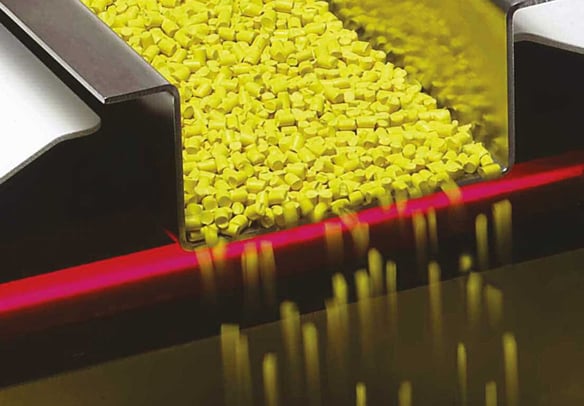
Not only does the CPA measure the size and shape of your particles, but it also provides information on the sphericity and circulatory of the material.
This technology has been monumental for the sand, gravel, plastic, coal, fertilizer, and food industries.
How Does a Computer Particle Analyzer Work?
The CPA is used to conduct a dynamic image analysis, which starts with loading the sample material in the funnel. Once ready, you will adjust the height of the funnel so that the material slowly trickles onto the feeder. The feeder will then begin to vibrate, pushing the material to the edge.
As the particles begin to fall, the line scan camera reads the shadows produced from the LED light. It is important that the light and the camera line up; otherwise, the CPA will produce an error message. Once the analysis is complete, you can collect your sample in the pan below the camera.
The last piece of this process is receiving and analyzing the data. This is done digitally on our parent company’s software, CPA serv. This software provides a wide range of customizable information. Below is a fairly standard chart you may see.
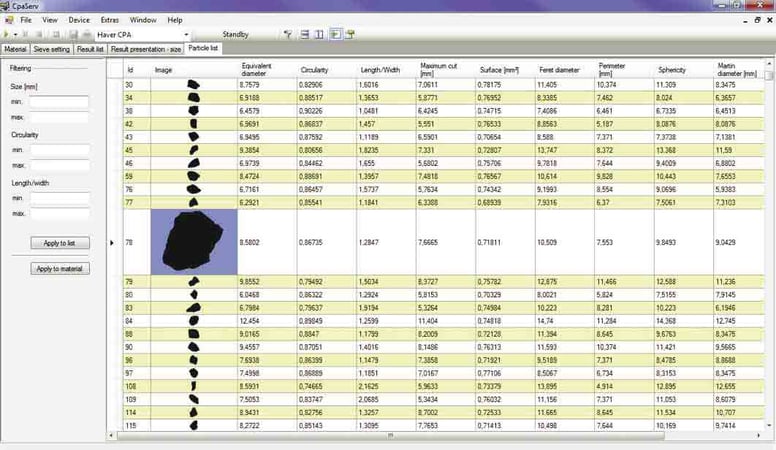
The most important factor to yielding accurate dynamic image analysis results is testing particles that are dry and free-flowing. If the material clumps together, then the line scan camera will not be able to distinguish each individual particle and will count it as one. Ultrasonic accessories can help alleviate this clumping issue.
What Is the CPA Used For?
As stated previously, the CPA uses a line scan camera that can scan up to 10,000 particles per second. This means the real value of the CPA comes when you are doing particle analysis on a large scale.
While the CPA is an advanced and high-tech piece of equipment, it may not be right for everyone.
For example, If you have one sieve shaker and use it 20 times a day or more, it might make sense for you to consider a CPA. On the other hand, if you are using your sieve shaker less than ten times a day, a CPA investment may not be beneficial to your operation.
Of course, there are many more examples and situations where you may want to consider a CPA.
What Are the Standards for a Computerized Particle Analyzer?
ASTM does not currently have a standard for dynamic image analysis. We do sit on an ASTM committee that is working on a standard for testing with alternative measures and hope this is finalized in the near future.
The CPA software correlates its results to standard test sieving. We recommend that you keep a stack of certified “master” or “control” sieves in your lab.
By running a sample through the test sieve stack every month or so, you can compare those results to the results from your CPA. This will allow you to check the performance of your CPA and make sure you are getting the accurate results needed to maintain the desired level of quality control.
How Much Does a CPA Cost?
There are a lot of factors that dictate the cost of a CPA. The equipment, software, setup, and training all affect the cost. The estimated cost for the most common CPA Unit is $60,000.
For a full breakdown of the cost of a CPA, take a moment and review our article: How Much Does A CPA Cost?
CPA Types: Laboratory Units & Industrial Units
There are two types of CPA models: laboratory and industrial. Of the two model types, there are 19 variants that are designed to be used with a specific particle size or type.
Laboratory Units
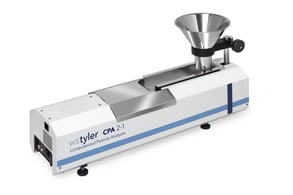 CPA 2-1
CPA 2-1
This is the most common CPA on the market. It can measure particles between 20 microns to 25 mm. As you can imagine, most material analysis can be performed in this size range. The footprint measures at 28 ¾” L x 10 ¼” W x 16 ¼ “ H
CPA Conveyor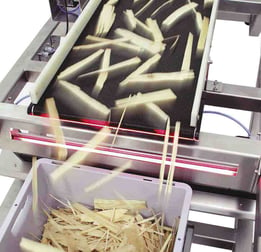
The CPA conveyor uses a belt instead of a vibrating tray. If testing elongated particles, the tray causes the particles to tumble off past the camera. This can produce false results for particle shapes, as we do not know how the particle fell past the line scan camera. In contrast, the belt projects the particles off at the same trajectory giving a more accurate reading.
Industrial Units
CPA Industrial Unit
The industrial size CPA has a much larger footprint and is typically not suitable for a laboratory setting. These units are typically 60”L x 32”W x 37” H; however, this may be different depending on what particles you are testing. An industrial CPA can run an analysis on particles from 40 microns to 15.
Final Thoughts
We know this was a lot of information to take in, so we want to sum up the two most important parts for you.
The CPA measures particles on a more accurate, efficient scale than a sieve shaker. It can perform a sieve analysis in as quick as four minutes.
When compares to a 30-minute test sieve analysis with a sieve shaker, this is pivotal.
Secondly, this process significantly reduces the risk of user error, giving you the most repeatable test results possible.
You May Also Find the Following Articles useful:
1. What is the ROI on a Computerized Particle Analyzer (CPA)?
2. Computer Particle Analyzers and the Frac Sand Industry
3. Sieve Shaker VS Computer Particle Analyzer (CPA)
4. Alpine Air Jet Sieve VS Computer Particle Analyzer (CPA)

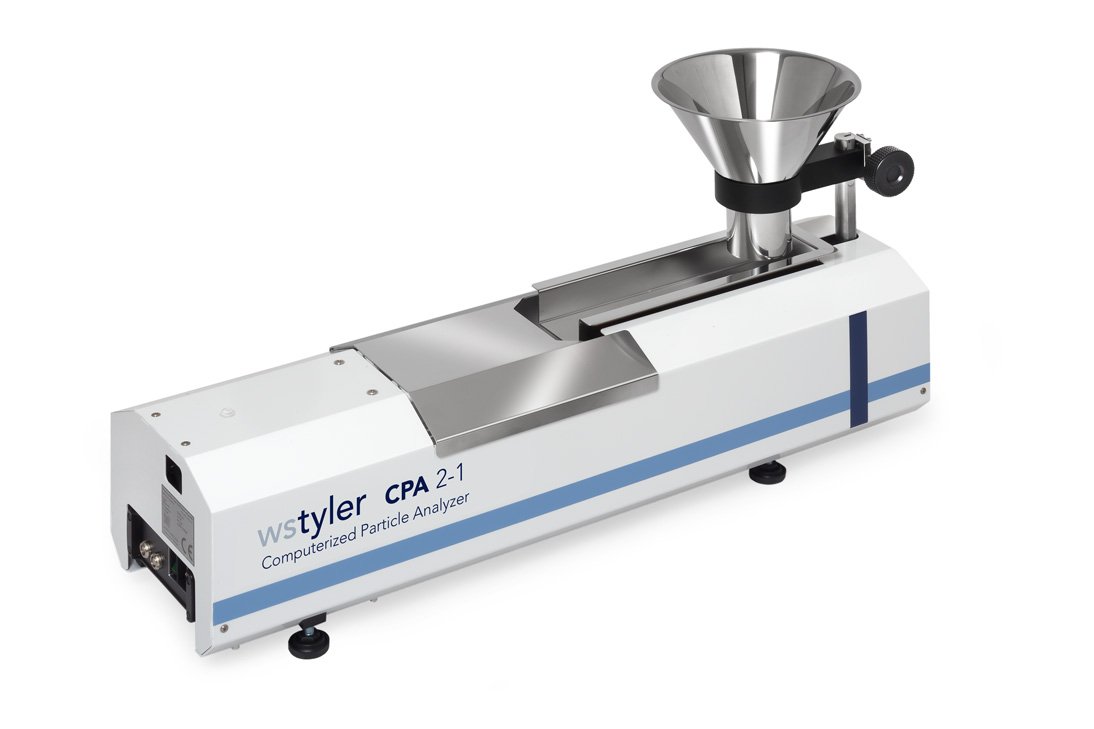


%20copy.jpg?width=297&name=CPA_1%20(1)%20copy.jpg)
